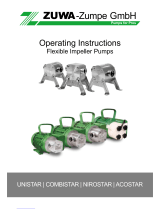Instruction manual CT centrifugal pumps 6
1. INSTALLATION
1.1 Receiving inspection
Although precaution is taken by us when packing and shipping, we urge you to carefully check the ship-
ment on receipt. Make sure that all parts and accessories listed on the packing list are accounted for.
Immediately report any damage or shortage to the transport company and to us.
1.2 Storage
If the equipment is to be stored prior to installation, place it in a clean location. Do not remove the
protective covers from the suction and discharge which have been fastened to keep pump internals free
of debris. Make sure to clean the pump thoroughly before installation.
1.3 Foundation
The pump-motor unit must stand on and be fixed to a sufficiently rigid structure that can support the
entire perimeter on which the unit stands. The foundation on a firm bottom are the most satisfactory.
Once the pump is in position, adjust level with metal shims between the feet and the surface on which
it stands. Check that the feet of the pump-motor unit stand well on each of them. The surface on which
the foundation stands must be flat and horizontal. If the unit is fitted on a steel structure, make sure that
it is supported so that the feet do not warp. In any case, it is advisable to fit some antivibration rubber
pieces between the pump and the brickwork.
For close-coupled type, pump-motor alignment is not required.
1.4 Piping connections
A pump is generally part of a piping system that can include a number of components such as valves,
fittings, filters, expansion joints, instruments, etc. The way the piping is arranged and the positioning of
the components has a great influence on operation and the operating life of the pump. The pump can-
not be used as a support for the components connected to it.
The flow of liquid from the pump must be as even as possible. It is advisable to avoid any tight bends or
drastic reductions of diameters that may cause flow resistance in the plant. In case of diameter reduction,
it is advisable to use appropriate conical reductions (possibly eccentric on suction side and concentric
on delivery side) at changes of diameter and at a minimum distance from pump inlets of five diameters.
1.4.1 Discharge pipe
A nonreturn valve and a shutoff/regulation valve are normally fitted on the discharge side.
The nonreturn valve protects the pump from any backflow. The shutoff/regulation valve excludes the
pump from the line and adjusts output. Never adjust flow-rate using the valve on the suction pipe.
1.4.2 Suction pipe
The suction piping is very important for the correct operation of the pump group. It must be as short and
as direct as possible. If a longer suction line is unavoidable, the diameter should be large enough, i.e.
at least as the inlet connection on the pump, to ensure less flow resistance. In any case, suction must
be carried out properly avoiding any air locks.
The CT pumps are single-stage centrifugal type, thus not self-priming. It will therefore always be necessary
to install a bottom valve in all cases when the static height of the liquid is lower than the suction height
of the pump. The suction piping must be without air inlets that are more probable with long suction lines
or if suction occurs with negative head. Critical points in these terms are also the seals between flanges
and the seals of the valve stems. Even some small air let into the suction line cause serious operating
problems that can make the pump stop.
!
!
!
!
!
!
Changes reserved without notice






















